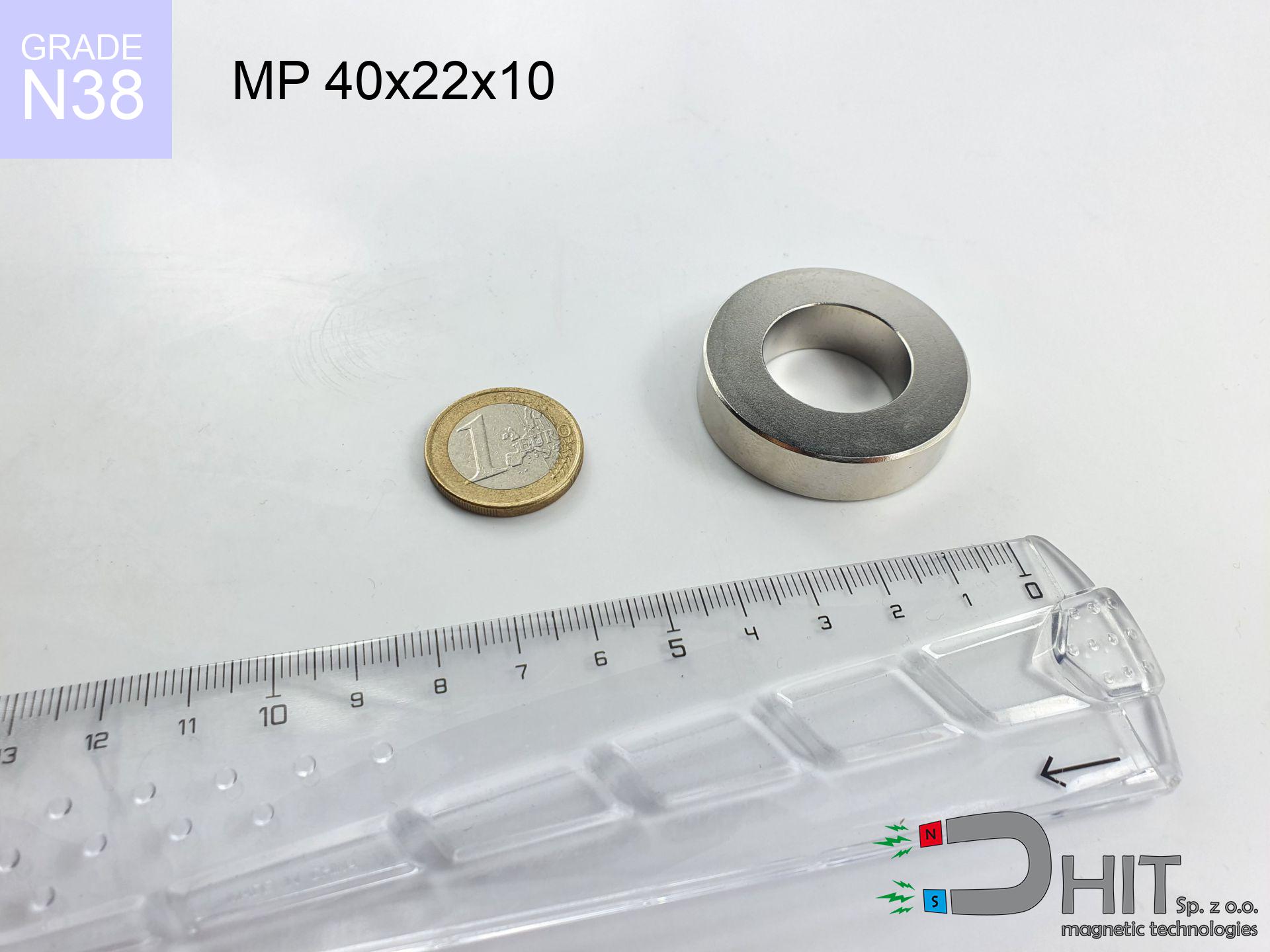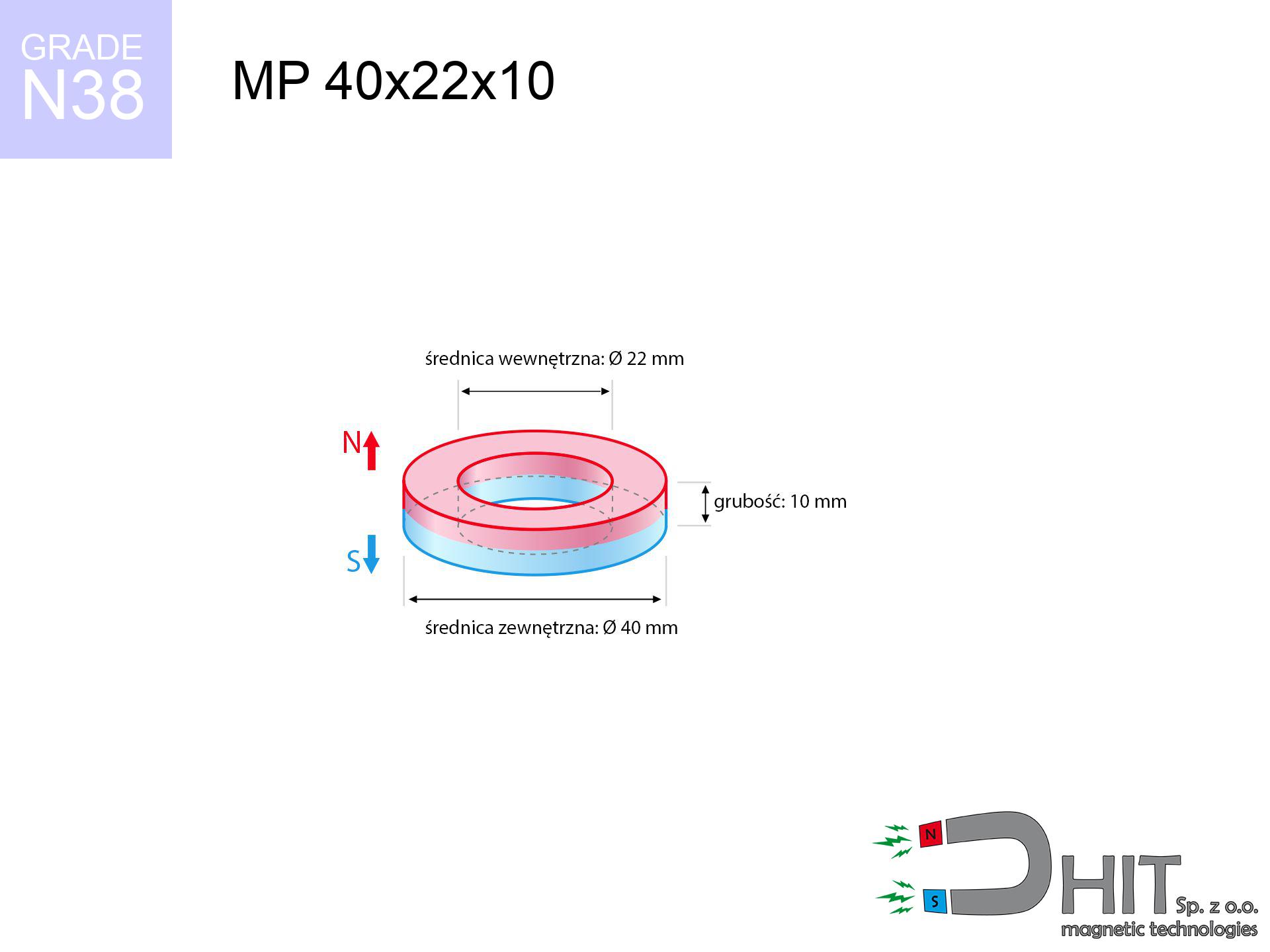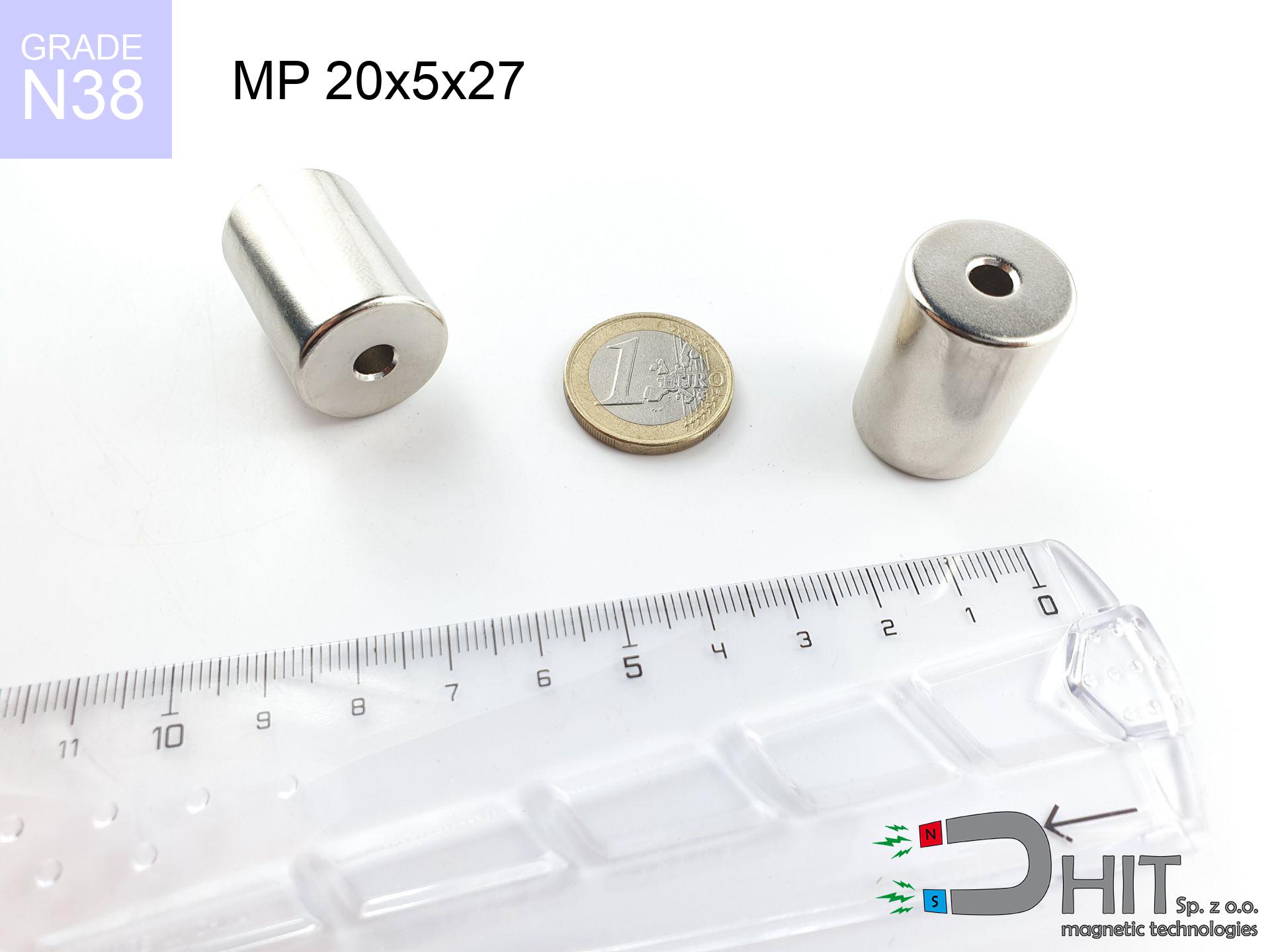MP 40x22x10 / N38 - ring magnet
ring magnet
Catalog no 030344
GTIN/EAN: 5906301812296
Diameter
40 mm [±0,1 mm]
internal diameter Ø
22 mm [±0,1 mm]
Height
10 mm [±0,1 mm]
Weight
65.74 g
Magnetization Direction
↑ axial
Load capacity
19.34 kg / 189.71 N
Magnetic Induction
277.22 mT / 2772 Gs
Coating
[NiCuNi] Nickel
40.59 ZŁ with VAT / pcs + price for transport
33.00 ZŁ net + 23% VAT / pcs
bulk discounts:
Need more?
Call us
+48 22 499 98 98
alternatively get in touch using
our online form
the contact form page.
Specifications and appearance of neodymium magnets can be reviewed using our
our magnetic calculator.
Orders submitted before 14:00 will be dispatched today!
Technical data of the product - MP 40x22x10 / N38 - ring magnet
Specification / characteristics - MP 40x22x10 / N38 - ring magnet
| properties | values |
|---|---|
| Cat. no. | 030344 |
| GTIN/EAN | 5906301812296 |
| Production/Distribution | Dhit sp. z o.o. |
| Country of origin | Poland / China / Germany |
| Customs code | 85059029 |
| Diameter | 40 mm [±0,1 mm] |
| internal diameter Ø | 22 mm [±0,1 mm] |
| Height | 10 mm [±0,1 mm] |
| Weight | 65.74 g |
| Magnetization Direction | ↑ axial |
| Load capacity ~ ? | 19.34 kg / 189.71 N |
| Magnetic Induction ~ ? | 277.22 mT / 2772 Gs |
| Coating | [NiCuNi] Nickel |
| Manufacturing Tolerance | ±0.1 mm |
Magnetic properties of material N38
| properties | values | units |
|---|---|---|
| remenance Br [min. - max.] ? | 12.2-12.6 | kGs |
| remenance Br [min. - max.] ? | 1220-1260 | mT |
| coercivity bHc ? | 10.8-11.5 | kOe |
| coercivity bHc ? | 860-915 | kA/m |
| actual internal force iHc | ≥ 12 | kOe |
| actual internal force iHc | ≥ 955 | kA/m |
| energy density [min. - max.] ? | 36-38 | BH max MGOe |
| energy density [min. - max.] ? | 287-303 | BH max KJ/m |
| max. temperature ? | ≤ 80 | °C |
Physical properties of sintered neodymium magnets Nd2Fe14B at 20°C
| properties | values | units |
|---|---|---|
| Vickers hardness | ≥550 | Hv |
| Density | ≥7.4 | g/cm3 |
| Curie Temperature TC | 312 - 380 | °C |
| Curie Temperature TF | 593 - 716 | °F |
| Specific resistance | 150 | μΩ⋅cm |
| Bending strength | 250 | MPa |
| Compressive strength | 1000~1100 | MPa |
| Thermal expansion parallel (∥) to orientation (M) | (3-4) x 10-6 | °C-1 |
| Thermal expansion perpendicular (⊥) to orientation (M) | -(1-3) x 10-6 | °C-1 |
| Young's modulus | 1.7 x 104 | kg/mm² |
Physical analysis of the product - data
The following information constitute the direct effect of a engineering simulation. Results are based on algorithms for the material Nd2Fe14B. Operational conditions may differ. Treat these calculations as a supplementary guide during assembly planning.
Table 1: Static pull force (pull vs distance) - power drop
MP 40x22x10 / N38
| Distance (mm) | Induction (Gauss) / mT | Pull Force (kg) | Risk Status |
|---|---|---|---|
| 0 mm |
5269 Gs
526.9 mT
|
19.34 kg / 19340.0 g
189.7 N
|
critical level |
| 1 mm |
5005 Gs
500.5 mT
|
17.46 kg / 17455.9 g
171.2 N
|
critical level |
| 2 mm |
4739 Gs
473.9 mT
|
15.65 kg / 15647.5 g
153.5 N
|
critical level |
| 3 mm |
4475 Gs
447.5 mT
|
13.95 kg / 13950.0 g
136.8 N
|
critical level |
| 5 mm |
3960 Gs
396.0 mT
|
10.93 kg / 10927.7 g
107.2 N
|
critical level |
| 10 mm |
2832 Gs
283.2 mT
|
5.59 kg / 5589.2 g
54.8 N
|
medium risk |
| 15 mm |
1990 Gs
199.0 mT
|
2.76 kg / 2760.5 g
27.1 N
|
medium risk |
| 20 mm |
1407 Gs
140.7 mT
|
1.38 kg / 1379.2 g
13.5 N
|
low risk |
| 30 mm |
745 Gs
74.5 mT
|
0.39 kg / 386.2 g
3.8 N
|
low risk |
| 50 mm |
268 Gs
26.8 mT
|
0.05 kg / 50.1 g
0.5 N
|
low risk |
Table 2: Vertical capacity (wall)
MP 40x22x10 / N38
| Distance (mm) | Friction coefficient | Pull Force (kg) |
|---|---|---|
| 0 mm | Stal (~0.2) |
3.87 kg / 3868.0 g
37.9 N
|
| 1 mm | Stal (~0.2) |
3.49 kg / 3492.0 g
34.3 N
|
| 2 mm | Stal (~0.2) |
3.13 kg / 3130.0 g
30.7 N
|
| 3 mm | Stal (~0.2) |
2.79 kg / 2790.0 g
27.4 N
|
| 5 mm | Stal (~0.2) |
2.19 kg / 2186.0 g
21.4 N
|
| 10 mm | Stal (~0.2) |
1.12 kg / 1118.0 g
11.0 N
|
| 15 mm | Stal (~0.2) |
0.55 kg / 552.0 g
5.4 N
|
| 20 mm | Stal (~0.2) |
0.28 kg / 276.0 g
2.7 N
|
| 30 mm | Stal (~0.2) |
0.08 kg / 78.0 g
0.8 N
|
| 50 mm | Stal (~0.2) |
0.01 kg / 10.0 g
0.1 N
|
Table 3: Vertical assembly (sliding) - behavior on slippery surfaces
MP 40x22x10 / N38
| Surface type | Friction coefficient / % Mocy | Max load (kg) |
|---|---|---|
| Raw steel |
µ = 0.3
30% Nominalnej Siły
|
5.80 kg / 5802.0 g
56.9 N
|
| Painted steel (standard) |
µ = 0.2
20% Nominalnej Siły
|
3.87 kg / 3868.0 g
37.9 N
|
| Oily/slippery steel |
µ = 0.1
10% Nominalnej Siły
|
1.93 kg / 1934.0 g
19.0 N
|
| Magnet with anti-slip rubber |
µ = 0.5
50% Nominalnej Siły
|
9.67 kg / 9670.0 g
94.9 N
|
Table 4: Steel thickness (saturation) - power losses
MP 40x22x10 / N38
| Steel thickness (mm) | % power | Real pull force (kg) |
|---|---|---|
| 0.5 mm |
|
0.97 kg / 967.0 g
9.5 N
|
| 1 mm |
|
2.42 kg / 2417.5 g
23.7 N
|
| 2 mm |
|
4.84 kg / 4835.0 g
47.4 N
|
| 5 mm |
|
12.09 kg / 12087.5 g
118.6 N
|
| 10 mm |
|
19.34 kg / 19340.0 g
189.7 N
|
Table 5: Thermal resistance (stability) - power drop
MP 40x22x10 / N38
| Ambient temp. (°C) | Power loss | Remaining pull | Status |
|---|---|---|---|
| 20 °C | 0.0% |
19.34 kg / 19340.0 g
189.7 N
|
OK |
| 40 °C | -2.2% |
18.91 kg / 18914.5 g
185.6 N
|
OK |
| 60 °C | -4.4% |
18.49 kg / 18489.0 g
181.4 N
|
OK |
| 80 °C | -6.6% |
18.06 kg / 18063.6 g
177.2 N
|
|
| 100 °C | -28.8% |
13.77 kg / 13770.1 g
135.1 N
|
Table 6: Magnet-Magnet interaction (attraction) - field collision
MP 40x22x10 / N38
| Gap (mm) | Attraction (kg) (N-S) | Repulsion (kg) (N-N) |
|---|---|---|
| 0 mm |
171.37 kg / 171369 g
1681.1 N
5 920 Gs
|
N/A |
| 1 mm |
163.01 kg / 163013 g
1599.2 N
10 277 Gs
|
146.71 kg / 146712 g
1439.2 N
~0 Gs
|
| 2 mm |
154.67 kg / 154674 g
1517.4 N
10 011 Gs
|
139.21 kg / 139207 g
1365.6 N
~0 Gs
|
| 3 mm |
146.55 kg / 146547 g
1437.6 N
9 744 Gs
|
131.89 kg / 131893 g
1293.9 N
~0 Gs
|
| 5 mm |
131.00 kg / 131000 g
1285.1 N
9 213 Gs
|
117.90 kg / 117900 g
1156.6 N
~0 Gs
|
| 10 mm |
96.83 kg / 96829 g
949.9 N
7 921 Gs
|
87.15 kg / 87146 g
854.9 N
~0 Gs
|
| 20 mm |
49.53 kg / 49525 g
485.8 N
5 665 Gs
|
44.57 kg / 44573 g
437.3 N
~0 Gs
|
| 50 mm |
6.33 kg / 6326 g
62.1 N
2 025 Gs
|
5.69 kg / 5694 g
55.9 N
~0 Gs
|
Table 7: Hazards (implants) - warnings
MP 40x22x10 / N38
| Object / Device | Limit (Gauss) / mT | Safe distance |
|---|---|---|
| Pacemaker | 5 Gs (0.5 mT) | 24.0 cm |
| Hearing aid | 10 Gs (1.0 mT) | 18.5 cm |
| Timepiece | 20 Gs (2.0 mT) | 14.5 cm |
| Mobile device | 40 Gs (4.0 mT) | 11.0 cm |
| Remote | 50 Gs (5.0 mT) | 10.5 cm |
| Payment card | 400 Gs (40.0 mT) | 4.5 cm |
| HDD hard drive | 600 Gs (60.0 mT) | 3.5 cm |
Table 8: Dynamics (kinetic energy) - warning
MP 40x22x10 / N38
| Start from (mm) | Speed (km/h) | Energy (J) | Predicted outcome |
|---|---|---|---|
| 10 mm |
20.18 km/h
(5.61 m/s)
|
1.03 J | |
| 30 mm |
30.33 km/h
(8.43 m/s)
|
2.33 J | |
| 50 mm |
38.74 km/h
(10.76 m/s)
|
3.81 J | |
| 100 mm |
54.70 km/h
(15.20 m/s)
|
7.59 J |
Table 9: Anti-corrosion coating durability
MP 40x22x10 / N38
| Technical parameter | Value / Description |
|---|---|
| Coating type | [NiCuNi] Nickel |
| Layer structure | Nickel - Copper - Nickel |
| Layer thickness | 10-20 µm |
| Salt spray test (SST) ? | 24 h |
| Recommended environment | Indoors only (dry) |
Table 10: Electrical data (Flux)
MP 40x22x10 / N38
| Parameter | Value | SI Unit / Description |
|---|---|---|
| Magnetic Flux | 54 070 Mx | 540.7 µWb |
| Pc Coefficient | 0.81 | High (Stable) |
Table 11: Hydrostatics and buoyancy
MP 40x22x10 / N38
| Environment | Effective steel pull | Effect |
|---|---|---|
| Air (land) | 19.34 kg | Standard |
| Water (riverbed) |
22.14 kg
(+2.80 kg Buoyancy gain)
|
+14.5% |
1. Wall mount (shear)
*Caution: On a vertical surface, the magnet retains only a fraction of its perpendicular strength.
2. Steel thickness impact
*Thin steel (e.g. computer case) drastically reduces the holding force.
3. Temperature resistance
*For N38 material, the safety limit is 80°C.
4. Demagnetization curve and operating point (B-H)
chart generated for the permeance coefficient Pc (Permeance Coefficient) = 0.81
This simulation demonstrates the magnetic stability of the selected magnet under specific geometric conditions. The solid red line represents the demagnetization curve (material potential), while the dashed blue line is the load line based on the magnet's geometry. The Pc (Permeance Coefficient), also known as the load line slope, is a dimensionless value that describes the relationship between the magnet's shape and its magnetic stability. The intersection of these two lines (the black dot) is the operating point — it determines the actual magnetic flux density generated by the magnet in this specific configuration. A higher Pc value means the magnet is more 'slender' (tall relative to its area), resulting in a higher operating point and better resistance to irreversible demagnetization caused by external fields or temperature. A value of 0.42 is relatively low (typical for flat magnets), meaning the operating point is closer to the 'knee' of the curve — caution is advised when operating at temperatures near the maximum limit to avoid strength loss.
Chemical composition
| iron (Fe) | 64% – 68% |
| neodymium (Nd) | 29% – 32% |
| boron (B) | 1.1% – 1.2% |
| dysprosium (Dy) | 0.5% – 2.0% |
| coating (Ni-Cu-Ni) | < 0.05% |
Ecology and recycling (GPSR)
| recyclability (EoL) | 100% |
| recycled raw materials | ~10% (pre-cons) |
| carbon footprint | low / zredukowany |
| waste code (EWC) | 16 02 16 |
Other products
Pros as well as cons of neodymium magnets.
Benefits
- They virtually do not lose power, because even after 10 years the performance loss is only ~1% (according to literature),
- Magnets effectively resist against demagnetization caused by foreign field sources,
- By using a smooth coating of nickel, the element presents an nice look,
- Magnets are distinguished by maximum magnetic induction on the working surface,
- Through (adequate) combination of ingredients, they can achieve high thermal resistance, enabling operation at temperatures approaching 230°C and above...
- Possibility of custom modeling as well as optimizing to specific needs,
- Universal use in innovative solutions – they serve a role in hard drives, drive modules, precision medical tools, and modern systems.
- Thanks to their power density, small magnets offer high operating force, in miniature format,
Weaknesses
- To avoid cracks upon strong impacts, we recommend using special steel housings. Such a solution secures the magnet and simultaneously increases its durability.
- NdFeB magnets demagnetize when exposed to high temperatures. After reaching 80°C, many of them experience permanent drop of power (a factor is the shape as well as dimensions of the magnet). We offer magnets specially adapted to work at temperatures up to 230°C marked [AH], which are extremely resistant to heat
- Magnets exposed to a humid environment can corrode. Therefore during using outdoors, we advise using waterproof magnets made of rubber, plastic or other material resistant to moisture
- Due to limitations in producing nuts and complex shapes in magnets, we propose using a housing - magnetic mechanism.
- Health risk to health – tiny shards of magnets pose a threat, if swallowed, which gains importance in the context of child health protection. Additionally, small elements of these devices can disrupt the diagnostic process medical in case of swallowing.
- Higher cost of purchase is one of the disadvantages compared to ceramic magnets, especially in budget applications
Holding force characteristics
Maximum lifting capacity of the magnet – what it depends on?
- on a plate made of structural steel, optimally conducting the magnetic flux
- with a cross-section no less than 10 mm
- with a plane free of scratches
- under conditions of no distance (surface-to-surface)
- during detachment in a direction perpendicular to the plane
- at conditions approx. 20°C
Lifting capacity in practice – influencing factors
- Distance (between the magnet and the plate), as even a microscopic clearance (e.g. 0.5 mm) results in a reduction in force by up to 50% (this also applies to varnish, corrosion or dirt).
- Force direction – remember that the magnet has greatest strength perpendicularly. Under sliding down, the capacity drops drastically, often to levels of 20-30% of the maximum value.
- Plate thickness – too thin plate does not close the flux, causing part of the power to be escaped into the air.
- Plate material – low-carbon steel attracts best. Alloy admixtures reduce magnetic permeability and lifting capacity.
- Plate texture – ground elements guarantee perfect abutment, which improves force. Rough surfaces reduce efficiency.
- Heat – NdFeB sinters have a sensitivity to temperature. When it is hot they lose power, and at low temperatures gain strength (up to a certain limit).
Lifting capacity was assessed by applying a smooth steel plate of optimal thickness (min. 20 mm), under perpendicular detachment force, whereas under parallel forces the load capacity is reduced by as much as 75%. In addition, even a minimal clearance between the magnet’s surface and the plate lowers the load capacity.
H&S for magnets
Product not for children
These products are not intended for children. Swallowing several magnets can lead to them attracting across intestines, which constitutes a direct threat to life and necessitates immediate surgery.
Handling guide
Before starting, read the rules. Uncontrolled attraction can break the magnet or injure your hand. Think ahead.
Electronic hazard
Data protection: Strong magnets can damage payment cards and sensitive devices (heart implants, medical aids, timepieces).
Phone sensors
Remember: neodymium magnets produce a field that disrupts precision electronics. Maintain a safe distance from your phone, device, and GPS.
Fragile material
Beware of splinters. Magnets can fracture upon uncontrolled impact, launching sharp fragments into the air. Eye protection is mandatory.
Allergy Warning
Allergy Notice: The nickel-copper-nickel coating contains nickel. If skin irritation occurs, cease working with magnets and use protective gear.
Do not drill into magnets
Dust generated during machining of magnets is self-igniting. Do not drill into magnets without proper cooling and knowledge.
Crushing risk
Large magnets can crush fingers in a fraction of a second. Do not place your hand betwixt two attracting surfaces.
Do not overheat magnets
Standard neodymium magnets (N-type) lose power when the temperature surpasses 80°C. The loss of strength is permanent.
Danger to pacemakers
Warning for patients: Strong magnetic fields affect medical devices. Maintain minimum 30 cm distance or request help to work with the magnets.






![UMGGW 29x8 [M4] GW / N38 - magnetic holder rubber internal thread UMGGW 29x8 [M4] GW / N38 - magnetic holder rubber internal thread](https://cdn3.dhit.pl/graphics/products/umg-29x8-m4-gw-duf.jpg)
![UMGGW 66x8.5 [M8] GW / N38 - magnetic holder rubber internal thread UMGGW 66x8.5 [M8] GW / N38 - magnetic holder rubber internal thread](https://cdn3.dhit.pl/graphics/products/umg-66x8.5-m6-gw-wud.jpg)

